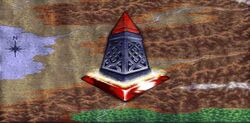
An obelisk atop a bloodforge and transferring mana.
Mana was a form of raw magic utilized by bloodforges and the mages who employed them in the Utter East.[1][2][3][4] It was also known as spell power.[3]
Description[]
Mana appeared as a kind of golden light.[1][note 1]
Philosophy[]
This raw magic was called "mana" by adherents of the Great Mage, who taught a number of principles of warfare related to the function and philosophy of the bloodforge and its use in battle. They saw mana as a kind of food that fed the bloodforge and their war effort.[2] Because of its uses and applications in bloodforge battles, mana was a fundamental resource in the Utter East.[3]
Generation & Storage[]
Owing to its own magical nature, a bloodforge slowly generated mana and could store a large amount of it collected from other sources (though this had a maximum limit). All of a mage's mana was stored in their bloodforge.[1][2][3]
More mana could be generated in various ways. Most commonly, a basal golem (created by a bloodforge) that sat idle meditated in the form of an obelisk and gathered mana, which it then transferred to the bloodforge in pulses once a certain amount had been accrued (but less could be transferred early).[1][2] However, the goblins of the Kingdom of Nix developed great cauldrons that would cook and stew a creature and yield mana to its owner.[1]
Mana orbs, gray spheres of magical energy, could be found that bestowed an instant burst of mana to one who touched them.[1]
Sacred urns, when carried by a slain creature, conveyed their essence in the form of mana back to their leader.[1]
Applications[]

A basal golem emerging from a bloodforge in a burst of mana.
With the power of a bloodforge, a mage could turn a portion of its mana into a kind of living golem called a basal golem, utterly loyal to the bloodforge's owner.[1][2][3] Mana was also used to transform basal golems into higher-level creatures, to cast spells, and trigger certain magical items.[1][3] It could also be used to heal a creature when adjacent to the bloodforge.[1]
History[]
During the time of the Bloodforge Wars (648–657 DR),[5] mana was extensively gathered and used to fuel the bloodforges, create and transform basal golem warriors, cast magic, and indeed power the whole wars themselves.[3]
Late in the wars, the great inventor Eldura Moreen worked tirelessly within the Hall of Wonder to unveil the mystery that was the essence of the bloodforge (perhaps referring to mana). But the leader of the Legendary Campaign resolved that no-one should know the secret of what the gods had wrought, and went there to put an end to Eldura's quest in a bloodforge battle.[6]
Appendix[]
Background[]
Mana is of course the ubiquitous system of mana points that fuel magic in countless fantasy roleplaying and video games. This derives from mana, a Polynesian and Melanesian concept of supernatural power, influence, or prestige. However, the text of the Readme file for the Blood & Magic (for the Interactive Demo only) says "We of the faith call this power mana, the food which nourishes our practice." This connection to food suggests instead manna (also spelled "mana"), a magical food in the Bible; the two concepts may have been conflated by game writers.
In-game descriptions appear to treat mana as a form of life energy, being used to create living golems, heal them, and transform them, and this mana can be gained from their deaths (in the sacred urn or cauldron). This is supported by the use of "blood" in the bloodforge and the game's name. However, it is unknown if all living creatures contain mana or if it is only golems simply reverted to their raw magical state. Since non-bloodforged-creatures exist as neutral units, and these may be harmed the same way, the former case appears to be true.
Dungeons & Dragons rarely uses a magic points system, so mana does not appear to be mentioned anywhere else in the Forgotten Realms. Nevertheless, it is hinted at in the names of the mana bow in Baldur's Gate II: Shadows of Amn and the Mana Forge in Baldur's Gate II: Throne of Bhaal, though the connection to mana is unknown.
Finally, mana bears a close resemblance to incarnum from Magic of Incarnum as described by Eytan Bernstein in the "Class Chronicles: Incarnum" article, as a Weave-related raw magic that permeates the world (rather than the soul energy it is in Magic of Incarnum) that can be shaped into magical objects.
Notes[]
- ↑ In-game animation and artwork depicts mana transference and basal golem creation and transformation with a golden or pale-yellow flash, suggesting this is the mana.
References[]
- ↑ 1.0 1.1 1.2 1.3 1.4 1.5 1.6 1.7 1.8 1.9 Tachyon Studios (November 1996). Designed by Brian Fargo. Blood & Magic. Interplay.
- ↑ 2.0 2.1 2.2 2.3 2.4 (1996). Blood & Magic Interactive Demo README.TXT , link:[1]. (Interplay).
- ↑ 3.0 3.1 3.2 3.3 3.4 3.5 3.6 (1996). Blood & Magic Instruction Manual (PDF). (Interplay).
- ↑ Interplay “Blood & Magic game advertising”. Dragon #236 (TSR, Inc.), p. 27.
- ↑ Brian R. James, Ed Greenwood (September 2007). The Grand History of the Realms. Edited by Kim Mohan, Penny Williams. (Wizards of the Coast), pp. 94, 95. ISBN 978-0-7869-4731-7.
- ↑ Tachyon Studios (November 1996). Designed by Brian Fargo. Blood & Magic. Interplay.
